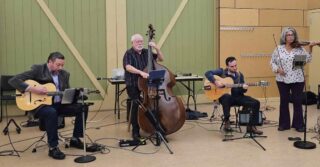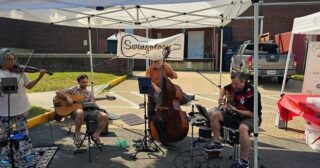Remote rehearsal software
We recently tried some remote rehearsal software for practice. We wanted something “real time” and low cost to use from our home studios. TIP: For real time jamming, you get the lowest network latency with your computer connected directly to your router via an old fashioned ethernet cable ( RJ45 Cat5 remember those?). Software-wise, there were a few options we considered:
jammr.net – free but not real time. At first this one looked good, but after reading docs we decided to try another. According to their documentation…
“ jammr sends your audio to other users and receives their audio. In order to avoid lag, jammr is live but not real-time. This means other players hear you after a fixed amount of time. This fixed amount is called the interval and can be set to fit the chord progression you are jamming to”
JamKazam – free and real time. The user interface looks nice. They have good media backing up their product line which features a low latency A/D and router device. They’re from Austin TX? Legit! The documentation outlines our desired features set. But when three of us created users, installed the application, and configured our audio settings, JamKazam regularly dropped connection to its server. Maybe their funding ran dry? This gave us a taste of what’s possible, but unfortunately was useless. Coincidentally the help documentation all returned 404 errors. There was some discussion in the global chat room about Salesforce discontinuing their support knowledgebase. Oh well. What’s next?
Jamulus – The sourceforge web page where you download Jamulus looks like something I built in 1997. Is this just malware disguised as something useful? The feature set and cost met our requirements. So we installed and configured Jamulus. The interface seems antique and utilitarian compared to JamKazam. But guess what? It WORKS! Scott hosted and privatized the server so random people weren’t joining in like Greed2 and Sololemel. We played through a few charts and each mixed a mic in with our instrument to converse, count in, etc. I think it worked well and had fun getting it together. Thanks guys! Now I need to find the longest ethernet cable on the planet to reach my router.
Check out this great article about Jamulus.
DistrictJam even hosts Jamulus servers for online jams in the nation’s capitol!
Jacktrip – a friend who works at Apple in Cupertino recently mentioned Jacktrip as an alternative. This is from the fine folks at Stanford’s CCRMA. From my experiences at CCRMA, I trust what goes on over there and am interested to try this one out. They’re operating as a non-profit, have open source software to download and prototype devices (including a Raspberry Pi image) to help reduce latency.
These days, there are more and more musicians sheltering in place. I know Larry at Palo Alto Violins sure is. Maybe this info will save you some bother, help bridge the social distance and keep us making music while we work through this pandemic.
Update: I just read about one more solution, SoundJack. It seems a lot like Jamulus and may be worth a try.
Another update: Reader Ulisses pointed out another option, Jamtaba. It’s based on the NINJAM server, and their documentation reminds me of the way jammr.net works…
“NINJAM provides a solution by making latency (and the weirdness) much longer. Latency in NINJAM is measured in measures, and that’s what makes it interesting. The NINJAM client records and streams synchronized intervals of music between participants. Just as the interval finishes recording, it begins playing on everyone else’s client. So when you play through an interval, you’re playing along with the previous interval of everybody else, and they’re playing along with your previous interval. “

























